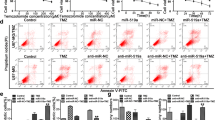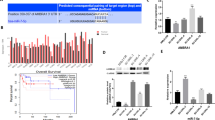Abstract
p72 is the member of the DEAD-box RNA helicase family, which can unwind double-stranded RNA and is efficient for microRNA (miRNA, miR) processing. However, its specific role in glioma has not been elucidated. First, the expression of p72 in glioma cell lines and tissues was explored using Western blot. To explore the role of p72 on glioma progression, adenovirus inhibiting p72 was transfected into A172 and T98G cells. Cell autophagy was determined using GFPLC3 dots, and cell apoptosis was determined using flow cytometry. The effect of Beclin1 was explored using GFP-LC3 dots, flow cytometry, and colony formation. The possible miRNAs that target the 3′-untranslated region (3′-UTR) of Beclin1 were predicted using TargetScan. Dual luciferase reporter assay was applied to determine whether these miRNAs bind to the 3′-UTR of Beclin1. The expression of p72 was significantly increased in glioma cell lines and tissues. Autophagy-related protein Beclin1 was found to be significantly enhanced when p72 was inhibited. The accumulation of GFP-LC3 dots was significant in cells transfected with ad-sh-p72 compared with ad-con. Colony formation capacity and cell apoptosis were also found to be significantly decreased with p72 inhibition. Furthermore, upregulation of Beclin1 contributes to A172 cell autophagy, invasion, and apoptosis. Overexpression of p72 induces increased miR-34-5p and miR-5195-3p expression in A172 and T98G cells. Beclin1 was the target gene of miR-34-5p and miR-5195-3p. In conclusion, we found for the first time that overexpression of p72 decreased Beclin1 expression partially by increasing miR-34-5p and miR-5195-3p expression in A172 and T98G cells.
Similar content being viewed by others
References
Omuro, A., and DeAngelis, L. M. (2013) Glioblastoma and other malignant gliomas: a clinical review, JAMA, 310, 1842–1850.
Koshkin, P. A., Chistiakov, D. A., and Chekhonin, V. P. (2013) Role of microRNAs in mechanisms of glioblastoma resistance to radioand chemotherapy, Biochemistry (Moscow), 78, 325–334.
Stupp, R., and Weber, D. C. (2005) The role of radioand chemotherapy in glioblastoma, Onkologie, 28, 315–317.
Ryu, C. H., Yoon, W. S., Park, K. Y., Kim, S. M., Lim, J. Y., Woo, J. S., Jeong, C. H., Hou, Y., and Jeun, S. S. (2012) Valproic acid downregulates the expression of MGMT and sensitizes temozolomide-resistant glioma cells, J. Biomed. Biotechnol., 98 74–95.
Stupp, R., Hegi, M. E., Mason, W. P., Van den Bent, M. J., Taphoorn, M. J., Janzer, R. C., Ludwin, S. K., Allgeier, A., Fisher, B., Belanger, K., Hau, P., Brandes, A. A., Gijtenbeek, J., Marosi, C., Vecht, C. J., Mokhtari, K., Wesseling, P., Villa, S., Eisenhauer, E., Gorlia, T., Weller, M., Lacombe, D., Cairncross, J. G., and Mirimanoff, R. O.; European Organisation for Research and Treatment of Cancer Brain Tumour and Radiation Oncology Groups; National Cancer Institute of Canada Clinical Trials Group (2009) Effects of radiotherapy with concomitant and adjuvant temozolomide versus radiotherapy alone on survival in glioblastoma in a randomised phase III study: 5-year analysis of the EORTC-NCIC trial, Lancet Oncol., 10, 459–466.
Yan, Y., Xu, Z., Dai, S., Qian, L., Sun, L., and Gong, Z. (2016) Targeting autophagy to sensitive glioma to temozolomide treatment, J. Exp. Clin. Cancer Res., 35, 23.
Wang, L., Long, L., Wang, W., and Liang, Z. (2015) Resveratrol, a potential radiation sensitizer for glioma stem cells both in vitro and in vivo, J. Pharmacol. Sci., 129, 216225.
Alers, S., Loffler, A. S., Wesselborg, S., and Stork, B. (2012) Role of AMPK-mTOR-Ulk1/2 in the regulation of autophagy: cross talk, shortcuts, and feedbacks, Mol. Cell. Biol., 32, 2–11.
Levine, B., and Kroemer, G. (2008) Autophagy in the pathogenesis of disease, Cell, 132, 27–42.
Araya, J., Hara, H., and Kuwano, K. (2013) Autophagy in the pathogenesis of pulmonary disease, Intern. Med., 52, 2295–2303.
Xavier, R. J., Huett, A., and Rioux, J. D. (2008) Autophagy as an important process in gut homeostasis and Crohn’s disease pathogenesis, Gut, 57, 717–720.
Liu, J. L., Chen, F. F., Chang, S. F., Chen, C. N., Lung, J., Lo, C. H., Lee, F. H., Lu, Y. C., and Hung, C. H. (2015) Expression of Beclin family proteins is associated with tumor progression in oral cancer, PLoS One, 10, e0141308.
Yue, Z., Jin, S., Yang, C., Levine, A. J., and Heintz, N. (2003) Beclin 1, an autophagy gene essential for early embryonic development, is a haploinsufficient tumor suppressor, Proc. Natl. Acad. Sci. USA, 100, 1507715082.
Qu, X., Yu, J., Bhagat, G., Furuya, N., Hibshoosh, H., Troxel, A., Rosen, J., Eskelinen, E. L., Mizushima, N., Ohsumi, Y., Cattoretti, G., and Levine, B. (2003) Promotion of tumorigenesis by heterozygous disruption of the Beclin 1 autophagy gene, J. Clin. Invest., 112, 18091820.
Song, J., Oh, Y., and Lee, J. E. (2015) miR-Let7A modulates autophagy induction in LPS-activated microglia, Exp. Neurobiol., 24, 117–125.
Chatterjee, A., Chattopadhyay, D., and Chakrabarti, G. (2014) miR-17-5p downregulation contributes to paclitaxel resistance of lung cancer cells through altering Beclin1 expression, PLoS One, 9, e95716.
Zhang, Y., Yang, W. Q., Zhu, H., Qian, Y. Y., Zhou, L., Ren, Y. J., Ren, X. C., Zhang, L., Liu, X. P., Liu, C. G., Ming, Z. J., Li, B., Chen, B., Wang, J. R., Liu, Y. B., and Yang, J. M. (2014) Regulation of autophagy by miR-30d impacts sensitivity of anaplastic thyroid carcinoma to cisplatin, Biochem. Pharmacol., 87, 562–570.
Chu, Y. D., Chen, H. K., Huang, T., and Chan, S. P. (2016) A novel function for the DEAD-box RNA helicase DDX23 in primary microRNA processing in Caenorhabditis elegans, Devel. Biol., 409, 459–472.
Linder, P., and Jankowsky, E. (2011) From unwinding to clamping–the DEAD box RNA helicase family, Nat. Rev. Mol. Cell Biol., 12, 505–516.
Jalal, C., Uhlmann-Schiffler, H., and Stahl, H. (2007) Redundant role of DEAD box proteins p68 (Ddx5) and p72/p82 (Ddx17) in ribosome biogenesis and cell proliferation, Nucleic Acids Res., 35, 3590–3601.
Retraction Fukuda, T., Yamagata, K., Fujiyama, S., Matsumoto, T., Koshida, I., Yoshimura, K., Mihara, M., Naitou, M., Endoh, H., Nakamura, T., Akimoto, C., Yamamoto, Y., Katagiri, T., Foulds, C., Takezawa, S., Kitagawa, H., Takeyama, K., O’Malley, B. W., and Kato, S. (2014) DEAD-box RNA helicase subunits of the Drosha complex are required for processing of rRNA and a subset of microRNAs, Nat. Cell Biol., 16, 1126.
Moy, R. H., Cole, B. S., Yasunaga, A., Gold, B., Shankarling, G., Varble, A., Molleston, J. M., tenOever, B. R., Lynch, K. W., and Cherry, S. (2014) Stem-loop recognition by DDX17 facilitates miRNA processing and antiviral defense, Cell, 158, 764–777.
Fukuda, T., Yamagata, K., Fujiyama, S., Matsumoto, T., Koshida, I., Yoshimura, K., Mihara, M., Naitou, M., Endoh, H., Nakamura, T., Akimoto, C., Yamamoto, Y., Katagiri, T., Foulds, C., Takezawa, S., Kitagawa, H., Takeyama, K., O’Malley, B. W., and Kato, S. (2007) DEAD-box RNA helicase subunits of the Drosha complex are required for processing of rRNA and a subset of microRNAs, Nat. Cell Biol., 9, 604–611.
Buckner, J. C. (2003) Factors influencing survival in highgrade gliomas, Semin. Oncol., 30, 10–14.
DeAngelis, L. M. (2001) Brain tumors, N. Engl. J. Med., 344, 114–123.
Kakkar, A., Sharma, M. C., Suri, V., Kaushal, S., Chandra, S. P., Garg, A., and Sarkar, C. (2014) Angiocentric glioma: a treatable cause of epilepsy: report of a rare case, Neurol. India, 62, 677–679.
Kong, B. H., Moon, J. H., Huh, Y. M., Shim, J. K., Lee, J. H., Kim, E. H., Chang, J. H., Kim, D. S., Hong, Y. K., Kim, S. H., Lee, S. J., and Kang, S. G. (2014) Prognostic value of glioma cancer stem cell isolation in survival of primary glioblastoma patients, Stem Cells Int., 8 38–950.
Russell, R. (2015) Unwinding the mechanisms of a DEADbox RNA helicase in cancer, J. Mol. Biol., 427, 17971800.
Epling, L. B., Grace, C. R., Lowe, B. R., Partridge, J. F., and Enemark, E. J. (2015) Cancer-associated mutants of RNA helicase DDX3X are defective in RNA-stimulated ATP hydrolysis, J. Mol. Biol., 427, 1779–1796.
Rocak, S., and Linder, P. (2004) DEAD-box proteins: the driving forces behind RNA metabolism, Nat. Rev. Mol. Cell Biol., 5, 232–241.
Caretti, G., Schiltz, R. L., Dilworth, F. J., Di Padova, M., Zhao, P., Ogryzko, V., Fuller-Pace, F. V., Hoffman, E. P., Tapscott, S. J., and Sartorelli, V. (2006) The RNA helicases p68/p72 and the noncoding RNA SRA are coregulators of MyoD and skeletal muscle differentiation, Dev. Cell, 11, 547–560.
Galluzzi, L., Pietrocola, F., Bravo-San Pedro, J. M., Amaravadi, R. K., Baehrecke, E. H., Cecconi, F., Codogno, P., Debnath, J., Gewirtz, D. A., Karantza, V., Kimmelman, A., Kumar, S., Levine, B., Maiuri, M. C., Martin, S. J., Penninger, J., Piacentini, M., Rubinsztein, D. C., Simon, H. U., Simonsen, A., Thorburn, A. M., Velasco, G., Ryan, K. M., and Kroemer, G. (2015) Autophagy in malignant transformation and cancer progression, EMBO J., 34, 856–880.
Guo, J. Y., Xia, B., and White, E. (2013) Autophagy-mediated tumor promotion, Cell, 155, 1216–1219.
Kenific, C. M., and Debnath, J. (2015) Cellular and metabolic functions for autophagy in cancer cells, Trends Cell Biol., 25, 37–45.
Perez, E., Das, G., Bergmann, A., and Baehrecke, E. H. (2015) Autophagy regulates tissue overgrowth in a contextdependent manner, Oncogene, 34, 3369–3376.
Kihara, A., Kabeya, Y., Ohsumi, Y., and Yoshimori, T. (2001) Beclin–phosphatidylinositol 3-kinase complex functions at the trans-Golgi network, EMBO Rep., 2, 330–335.
Janknecht, R. (2010) Multi-talented DEAD-box proteins and potential tumor promoters: p68 RNA helicase (DDX5) and its paralog, p72 RNA helicase (DDX17), Am. J. Transl. Res., 2, 223–234.
Author information
Authors and Affiliations
Corresponding author
Additional information
Originally published in Biochemistry (Moscow) On-Line Papers in Press, as Manuscript BM15-382, April 3, 2016.
Rights and permissions
About this article
Cite this article
Zhang, Z., Tian, H., Miao, Y. et al. Upregulation of p72 enhances malignant migration and invasion of glioma cells by repressing Beclin1 expression. Biochemistry Moscow 81, 574–582 (2016). https://doi.org/10.1134/S0006297916060031
Received:
Revised:
Published:
Issue Date:
DOI: https://doi.org/10.1134/S0006297916060031




